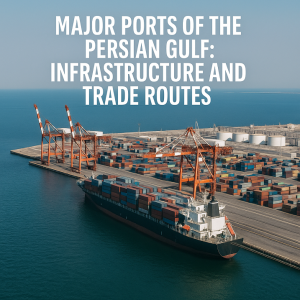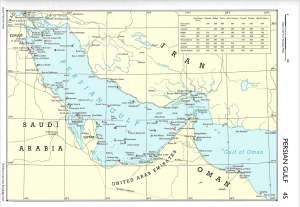Explore the major ports of the Persian Gulf, from Dubai to Dammam. Learn how these ports shape global trade routes through cutting-edge infrastructure, strategic location, and evolving logistics capabilities.

Where Geography Meets Global Trade
The Persian Gulf is one of the most strategically significant maritime corridors in the world. Bordered by energy-rich nations such as Saudi Arabia, Iran, the UAE, Kuwait, and Qatar, this enclosed sea hosts some of the busiest and most modern ports in the global shipping network. With access to the Strait of Hormuz, these ports serve as vital gateways for crude oil, liquefied natural gas (LNG), petrochemicals, containerized goods, and more.
The infrastructure development across these ports in the last two decades has transformed the region into a global logistics hub. According to IHS Markit (2024), Persian Gulf ports collectively handled over 700 million metric tons of cargo in 2023, with container volumes surging due to diversification beyond hydrocarbons.
This article provides an in-depth look at the Persian Gulf’s major ports, their facilities, trade flows, and how they fit into global supply chains, particularly in light of shifting geopolitical and environmental considerations.
Why Persian Gulf Ports Matter in Global Maritime Trade
The Persian Gulf ports serve as the linchpin between East-West trade corridors, acting as transshipment hubs, energy export terminals, and import centers for the Middle East. Here’s why they matter:
-
Energy Exports: Over 30% of global crude oil exports originate here, especially through Ras Tanura, Mina Al Ahmadi, and Kharg Island.
-
Strategic Access: Via the Strait of Hormuz, ships connect with the Arabian Sea, Indian Ocean, and global sea lanes.
-
Port Modernization: The UAE’s Jebel Ali and Qatar’s Hamad Port have invested in automated container terminals and green port technologies.
-
Diversified Cargo: Increasing focus on non-oil exports like aluminum, steel, fertilizers, and general cargo.
With China’s Belt and Road Initiative, India’s west coast partnerships, and the EU’s interest in energy security, Persian Gulf ports are more geopolitically and economically relevant than ever.

Key Persian Gulf Ports and Their Infrastructure
Bandar Abbas Port – Iran
Location: Bandar Abbas, Iran
Operator: Ports and Maritime Organization (PMO) of Iran
Specialization: Container shipping, bulk cargo, ro-ro, petroleum products
Annual Throughput: ~3.5 million TEUs (2023)
-
Strategic gateway on the Strait of Hormuz, vital for global oil and trade routes.
-
Multi-purpose hub handling containers, oil, and automotive shipments.
-
Expanding modern terminals with rail links to Tehran and INSTC trade corridors.
-
Deep-water berths accommodate ultra-large container vessels (ULCVs) and tankers.
Trade Focus: China, India, UAE, Russia, Central Asia
Chabahar Port – Iran
Location: Chabahar, Iran
Operator: PMO of Iran / India Ports Global Limited (IPGL)
Specialization: Transit trade, bulk cargo, Afghanistan gateway
Annual Throughput: ~100,000 TEUs (2023)
-
India’s strategic alternative to Gwadar, bypassing Pakistan for Afghan trade.
-
Deep-water port (100,000 DWT capacity) with a Special Economic Zone (SEZ).
-
Phase-I (Shahid Beheshti Terminal) linked to Afghanistan via Zaranj-Delaram Highway.
-
Future rail connectivity to Central Asia via INSTC.
Trade Focus: India, Afghanistan, Central Asia
Bandar Imam Khomeini Port – Iran
Location: Khuzestan, Iran
Operator: PMO of Iran
Specialization: Petrochemicals, bulk cargo, grain
Annual Throughput: ~3 million TEUs (2023)
-
Iran’s largest petrochemical export hub, serving oil/gas and industrial cargo.
-
Integrated with Trans-Iranian Railway for cargo to Tehran and Turkey.
-
Deep-draft terminals for tankers and bulk carriers.
-
Adjacent to Mahshahr Petrochemical Zone.
Trade Focus: China, UAE, Turkey, India
Bandar Basra (Al Maqal Port) – Iraq
Location: Basra, Iraq
Operator: Iraqi Ports Authority
Specialization: General cargo, containers, oil
Annual Throughput: ~1 million TEUs (2023)
-
Iraq’s primary commercial port, critical for food and construction imports.
-
Multi-terminal operations (Umm Qasr, Al Maqal) with oil export links.
-
Shallow draft limits large vessels (awaiting Grand Faw Port completion).
-
Road links to Baghdad and future rail under Iraq Development Road Project.
Trade Focus: UAE, China, Turkey, India
Jebel Ali Port – United Arab Emirates
Location: Dubai, UAE
Operator: DP World
Specialization: Container shipping, logistics, ro-ro, breakbulk
Annual Throughput: 14.1 million TEUs (2023)
-
One of the world’s largest man-made ports
-
Hosts Jebel Ali Free Zone (JAFZA), a major manufacturing and logistics cluster
-
Features fully automated terminals, AI-driven yard management, and deep-draft berths for ultra-large container vessels (ULCVs)
-
Connected by rail and road to Dubai International Airport and GCC transport corridors
Trade Focus: China, India, East Africa, Red Sea, Europe
Port of Dammam (King Abdul Aziz Port) – Saudi Arabia
Location: Eastern Province, KSA
Operator: Saudi Ports Authority (MAWANI)
Annual Cargo Volume: ~25 million tons
Specialization: Containerized cargo, automobiles, industrial imports
-
Largest commercial port in Saudi Arabia’s Persian Gulf coast
-
Home to Saudi Global Ports (SGP), a joint venture with PSA International
-
Recent upgrades include smart port systems and blockchain integration via TradeLens
Trade Focus: Imports of construction materials, food products, industrial equipment
Port of Fujairah – UAE
Location: Outside the Strait of Hormuz, UAE
Specialization: Bunkering, crude oil exports, petroleum storage
Significance:
-
Only multi-purpose port on UAE’s eastern seaboard
-
Bunkering hub ranking third globally after Singapore and Rotterdam
-
Hosts ADNOC’s Strategic Crude Oil Terminal
Serves as a strategic bypass for oil exports during high-tension scenarios in the Strait of Hormuz.
Hamad Port – Qatar
Location: Mesaieed, near Doha
Operator: Qatar Ports Management Company (Mwani Qatar)
Annual Capacity: 7.5 million TEUs (planned)
-
Operational since 2017, built at a cost of over USD 7.5 billion
-
Features automated cranes, eco-friendly operations, and cold chain logistics for perishables
-
A key node in Qatar’s post-blockade trade strategy, increasing trade with Turkey, Iran, and India
Trade Focus: Food, building materials, LNG shipping, general cargo
Mina Al Ahmadi – Kuwait
Location: Southern Kuwait
Operator: Kuwait National Petroleum Company (KNPC)
Specialization: Oil export terminal
Infrastructure Highlights:
-
Connects to Kuwait’s largest refinery
-
Berths for VLCCs and Suezmax tankers
-
Exports up to 2.6 million barrels/day of crude and derivatives
Kharg Island – Iran
Location: Northern Gulf
Operator: National Iranian Oil Company (NIOC)
Significance:
-
Iran’s principal oil export terminal
-
Connected to over 90% of the country’s offshore and onshore oil output
-
Continues limited exports under sanctions-compliant barter agreements and waivers
–
Trade Routes and Intermodal Connectivity
Persian Gulf ports are connected to global trade lanes and regional hinterlands via:
-
Strait of Hormuz Transit: Chokepoint for westbound exports to the Red Sea, Suez Canal, and Mediterranean
-
Indian Subcontinent Routes: Daily container and tanker departures to Mumbai, Mundra, and Colombo
-
Africa–Asia Axis: Jebel Ali and Hamad Port act as transshipment centers for East African cargo
-
Intra-GCC Trade: Shortsea shipping between Oman, Bahrain, and KSA facilitates regional resilience
New initiatives like Etihad Rail (UAE) and the Gulf Railway project promise enhanced hinterland connectivity for cargo distribution across the Arabian Peninsula.
Challenges Facing Gulf Port Operations
Despite modernization, ports in the Persian Gulf face a series of challenges:
Geopolitical Risk
-
Tensions between Iran and GCC nations affect insurance premiums and vessel routing
-
IMO and Lloyd’s Market Association (LMA) classify the Strait of Hormuz as a High Risk Area
Environmental Pressures
-
Climate change raises sea levels and storm frequency, impacting dredging and mooring operations
-
Marine pollution regulations under MARPOL Annex V and VI demand cleaner port practices
Regional Competition
-
Ports compete for transshipment volumes and foreign investment
-
Projects like Saudi Arabia’s NEOM Port may disrupt existing cargo flows
–
Future Outlook: Smart, Green, and Strategic
Modernization plans across Persian Gulf ports are driven by digitalization, sustainability, and diversification.
Smart Port Technologies
-
Digital twins and blockchain-based cargo tracking improve transparency
-
AI-powered berth scheduling enhances turnaround times
-
IoT devices monitor reefers, bunkering, and mooring lines
Green Port Initiatives
-
Jebel Ali and Hamad Port integrate shore power (cold ironing) and low-emission zones
-
Solar and wind installations are planned in port hinterlands
Strategic Expansion
-
New terminals under construction in Kuwait’s Mubarak Al-Kabeer Port and Saudi Arabia’s Ras Al Khair Port
-
Long-term logistics visions align with Vision 2030 (KSA) and UAE Maritime Strategy 2030
–
Frequently Asked Questions
Which is the busiest port in the Persian Gulf?
Jebel Ali Port is the region’s busiest container port and among the top 10 globally.
Are Persian Gulf ports safe for shipping?
Yes, but certain zones (especially near the Strait of Hormuz) are considered high-risk by insurers. Vessels follow IMO Best Management Practices (BMP5).
Do these ports handle only oil?
No. While energy is dominant, ports like Hamad Port, Jebel Ali, and Dammam handle containerized cargo, ro-ro, and bulk goods.
What is the role of free zones?
Free zones adjacent to ports (like JAFZA) boost foreign investment, manufacturing, and re-export activities, making them critical economic drivers.
Are these ports integrated with rail and road?
Increasingly so. The Etihad Rail and GCC Rail projects aim to connect ports to industrial zones and neighboring countries.
Conclusion: Ports That Power the Region
The Persian Gulf’s ports are more than just loading and unloading points—they are economic engines and geopolitical pressure valves. With cutting-edge infrastructure, smart logistics, and ambitious expansion plans, these ports are shaping the future of maritime trade across Asia, Africa, and Europe.
As global supply chains evolve post-COVID and amid energy transitions, ports like Jebel Ali, Hamad, and Dammam will play a pivotal role in how goods and resources flow across continents.
For students, professionals, and strategists in the maritime industry, understanding the Persian Gulf’s port infrastructure is essential to navigating the future of global trade.

